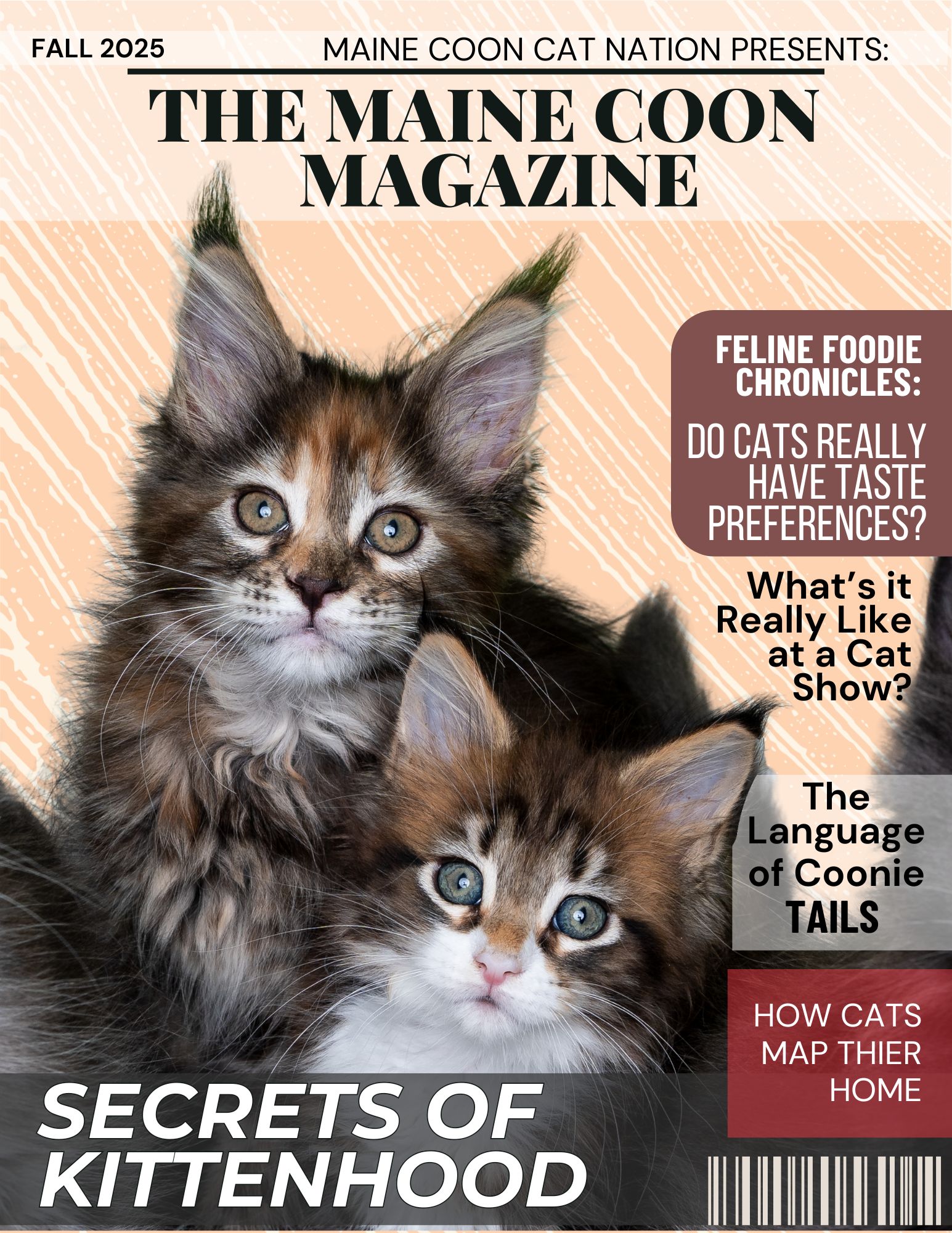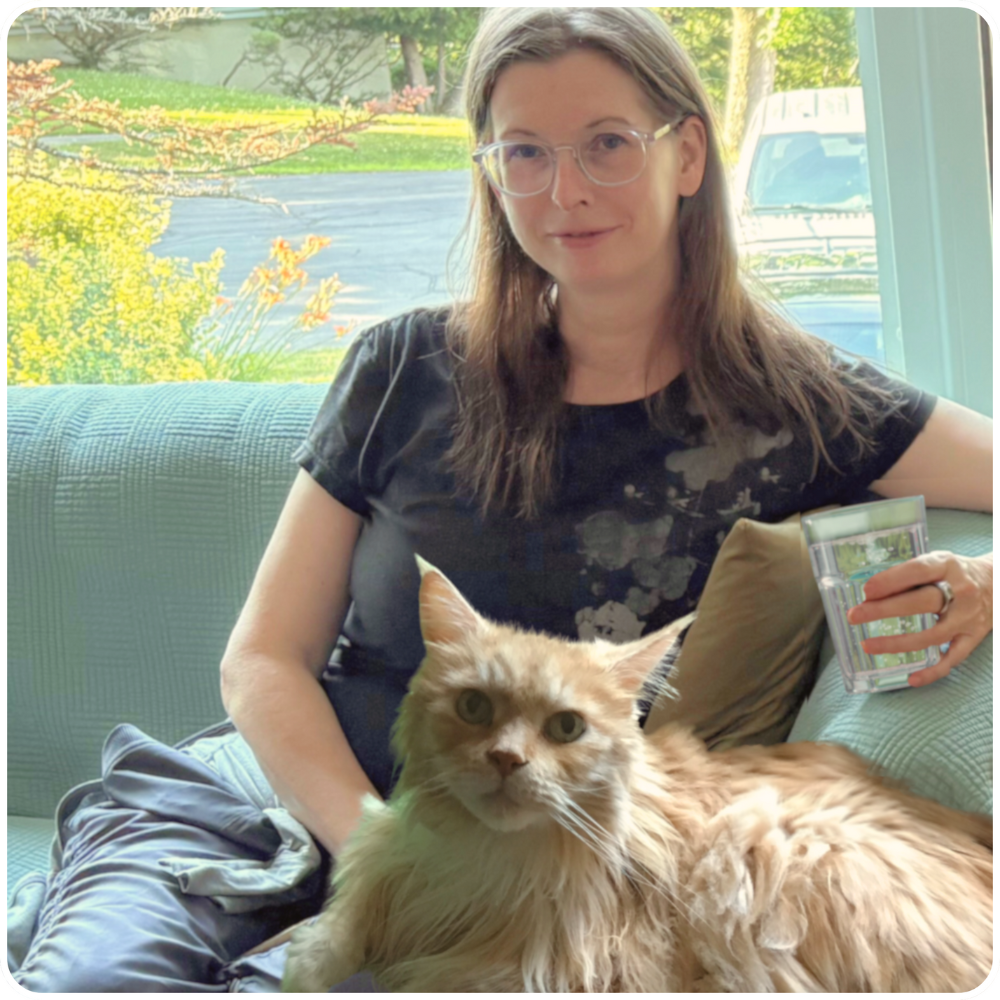Let’s Talk Maine Coon Cat Markings & Patterns
If you’ve ever tried to describe your cat's coat and found yourself saying things like "she’s kind of striped, but also has spots... and her belly is white, but her back is grayish?" - you’re not alone.
Some markings can be surprisingly tricky to explain! They're the unique patterns and patches of color on a cat’s coat that make each kitty look totally one-of-a-kind.
If you like this, you'll love our fun, free Daily Digest!

If you like this, you'll love our fun, free Daily Digest!

When we talk about Maine Coon cat markings, we’re really talking about the different ways color shows up on the fur.
Some cats have bold swirls or classic stripes, others have smoky undertones or a dusting of white on their paws and nose. And while certain patterns are more common, there’s a lot of variety - even in the same litter.
So whether your Coonie looks like a tiny lion or a walking marble cake, those markings have a backstory.
Let’s take a closer look at what’s behind them - from patterns and colors to a bit of fun coat genetics.
Basic Color Genetics in Maine Coons
Let's talk genes - don't worry, not the complicated kind. Just the fun cat version that decides whether your Coonie ends up a smoky beauty, a striped wonder, or a patchwork of colors that makes people stop and say, "Wait... what kind of cat is that?"
Every kitty's coat is the result of a mix of inherited traits from mom and dad. The basics boil down to a few key factors:
- Color (like black, red, or dilute versions such as blue and cream)
- Pattern type (like tabby, solid, or tortie)
- Modifiers (like white spotting or smoke)
For example, a black cat might carry a gene that makes her coat appear blue (a softer gray) instead. A red tabby might have a gene that adds white mittens or a belly splash.
And a solid-colored guy might secretly be a tabby at heart - his stripes just don’t show through unless you catch him in the right lighting.
Tortoiseshells and calicos? That’s where it gets fun. These are almost always female because of how the color genes sit on the X chromosome.
Boys can be tortie too, but it's super rare and usually means there's something extra going on genetically.
So when you look at Maine Coon cat markings, you're really seeing genetics in action - passed down from generations of fabulous felines. It's like nature’s own art project, with each coat telling a different story.
Primary Marking Types
There's a lot of variety when it comes to how a Coonie's coat shows up.
Some have bold stripes, others are solid-colored with little surprises tucked under their fur, and a few look like they were painted by a very creative artist.
Here’s a breakdown of the main types you'll see when it comes to Maine Coon cat markings:
Tabby:
This is the most common coat pattern for a Coonie. It's probably what pops into your head when you picture one. Think stripes, swirls, or spots, plus that signature "M" on the forehead that tabby cats are known for.
But "tabby" isn't just one look - it’s a whole category with several distinct styles:
🍂 Classic Tabby (also called "blotched tabby")
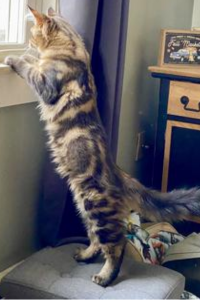 Falkor
FalkorBig, bold swirls or whorls that look almost like a marble cake.
You’ll usually see a bullseye pattern on each side of the cat.
This pattern gives off serious drama and is super common in brown tabby Maine Coons.
🐯 Mackerel Tabby
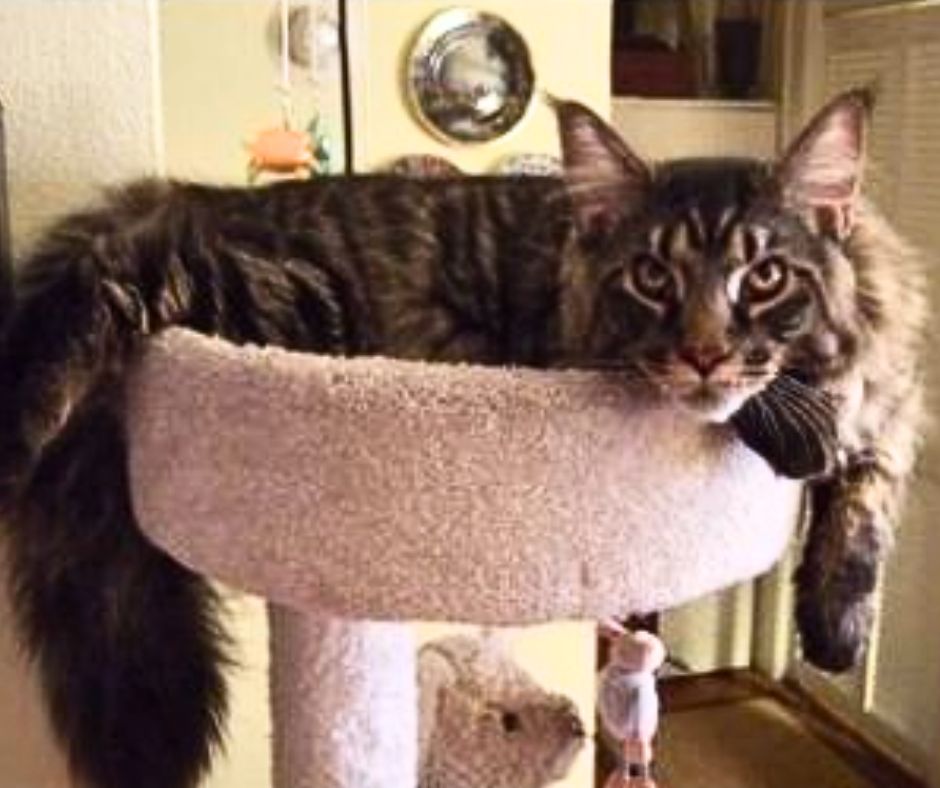 Bentley
BentleyThin, evenly spaced stripes that run vertically down the sides - like a tiger, but with fluffier cheeks.
These stripes may branch out slightly from the spine, giving a more uniform, striped appearance. It's the most "striped" version of tabby.
🐆 Spotted Tabby
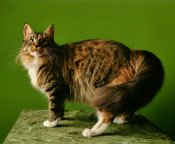
Instead of stripes or swirls, these kitties have spots! Some are round, some are more oval, and they can vary in size.
This one’s less common in Coonies but still possible - especially if there's a little mix in the family tree.
🌀 Ticked Tabby (also called “agouti”)
This one’s sneaky. At first glance, the coat looks almost solid, but up close, each individual hair is banded with multiple colors.
You’ll usually still see some faint tabby striping on the legs and face. Abyssinians are famous for it, but in some cases Maine Coons can carry it too.
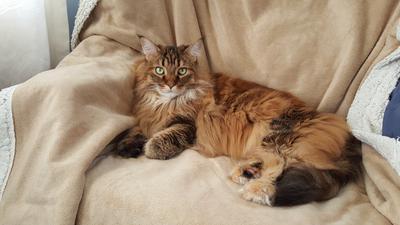 Kimber is a Brown Patch Tabby
Kimber is a Brown Patch TabbyA brown patch tabby is a cat that combines tabby stripes or swirls with patches of red or orange. Think of it like a mix between a brown tabby and a tortoiseshell - except the tabby pattern is still clearly visible.
Here’s a quick breakdown:
- "Brown" refers to the base tabby coloring (usually a warm brown with black or dark brown stripes).
- "Patch" means there are noticeable areas of another color - in this case, red or orange.
- "Tabby" tells you the coat still has that striped, swirled, or spotted pattern somewhere in the mix.
You'll sometimes hear this called a tortoiseshell tabby or a torbie (short for tortie + tabby), but "brown patch tabby" is a more specific way of saying the cat has a brown tabby base with orange or red mixed in.
👩🦰 And yes - just like torties and calicos, these patchy patterns are almost always female.
That's because the genes for red and black live on the X chromosome, so you need two Xs to show both.
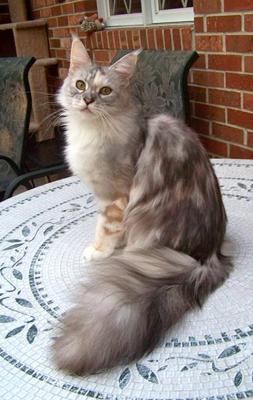 Candy Cane
Candy CaneIn short:
A Brown Patch Tabby is a striped or swirled kitty with bonus red/orange patches sprinkled in. Equal parts attitude and adorable.
Meet Kelimcoons Candy Cane: Dunja's beautiful girl is a Silver Patch Tabby With White.
So she has the base coloring of a Silver Tabby, with those gorgeous reddish areas. See them on her leg and back?
So unique! It reminds me of a stained glass artwork!
🎭 Tabby with White
You’ll also see lots of tabbies with patches of white - on the face, chest, paws, or belly.
These are still true tabbies, just with some extra contrast and flair. Super common and super cute.
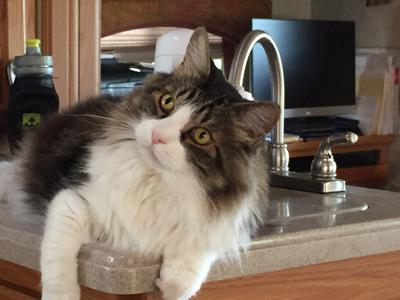 Toby
TobyNo matter the tabby type, you’ll usually get expressive facial markings, rings on the tail, and stripes or swirls down the legs.
And since most Coonies fall into the tabby group (especially the classic brown variety), it’s the pattern people are most curious about when diving into Maine Coon cat markings.
Each tabby cat wears their stripes (or swirls or spots) a little differently—kind of like a fingerprint.
Solid:
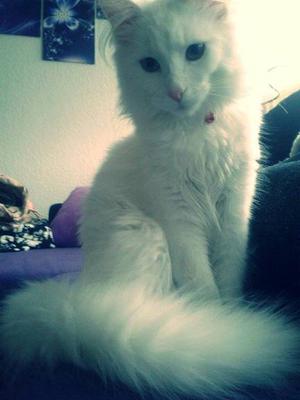
A solid coat means one consistent color from nose to tail - no stripes, no patches, just sleek and even. These cats can be black, white, blue (gray), cream, red - you name it.
Sometimes you’ll spot faint ghost stripes, especially in kittens, but they often fade as the cat matures.
Solid-colored kitties tend to look especially regal, even when they’re up to mischief.
Bi-color:
These kitties have a base color (like black, blue, or red) mixed with white - think tuxedo vibes, white mittens, or that sweet splash across the nose.
The amount of white can range from just a smidge on the toes to big patches all over.
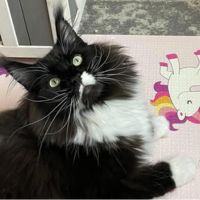 Maddy
MaddyOne of the most dramatic versions is called a Van - where almost the entire body is white, with just a touch of color on the head and tail.
It really does look like someone got a little wild with a paintbrush and then stopped halfway through!
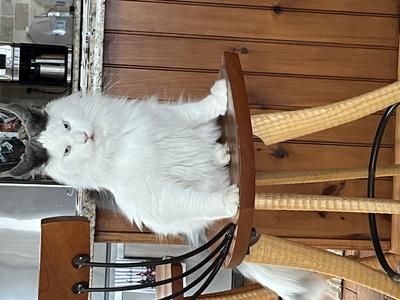 Milkman has that classic Van coloring
Milkman has that classic Van coloringSmoke/Shaded
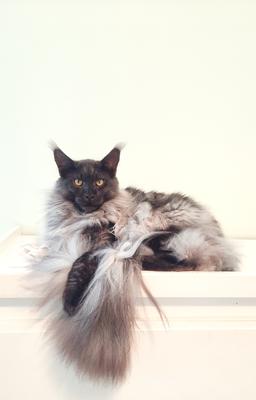
Now we're getting fancy. Smoke and shaded coats are all about subtle drama.
These cats usually look like they’re one solid color, but when they move or the light hits just right, you’ll see a lighter undercoat peeking through.
Smokes have more contrast (dark tips, light roots), while shaded coats are a bit more blended.
It’s a total showstopper when you catch it.
Tortoiseshell/Calico
If your feline is rocking a mix of red (or cream) and black (or blue), she's likely a tortie. Calicos are similar, but with white thrown into the mix.
These coats are almost always seen in females and look like a swirl of color - each one completely unique. No two ever look the same, and that’s part of the charm.
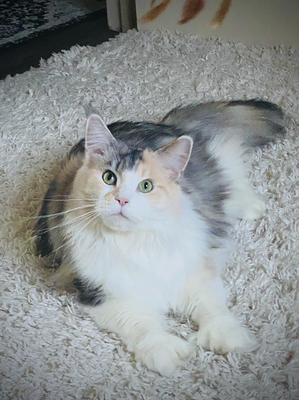
No matter the pattern or color combo, every Coonie wears their coat a little differently. It's one of the things that makes this breed such a standout - there’s no "standard" look, and that’s exactly why we love them.
How Markings Are Passed Down
Have you ever wondered why one kitten ends up striped like a tiger and her brother looks like he’s wearing a tuxedo - in the same litter?
It all comes down to what their parents pass along. Just like eye color or hair texture in people, a cat’s coat is shaped by genetics - and it’s honestly kind of fascinating.
Every Coonie inherits a mix of color and pattern genes from mom and dad. Some traits are dominant, meaning they’re more likely to show up, while others are recessive and only appear if both parents carry the gene.
For example, tabby is a dominant pattern - so if even one parent is a tabby, there’s a good chance their kittens will be, too.
White spotting, solid coats, and those dramatic smoke effects come from other genes that work with or against the base color and pattern.
It’s like a genetic tug-of-war, with each kitten ending up with a slightly different combo. That’s why you might have a litter with a tabby, a bi-color, and a little tortie all snuggled up together.
And remember tortoiseshells and calicos? Those are mostly female because the genes for red and black live on the X chromosome.
Since girls have two Xs, they can show both colors at once - hello, patchy perfection.
So when you're looking at Maine Coon cat markings, you’re really seeing generations of gene shuffling at work.
Every swirl, stripe, and splash of color has a backstory, even if your kitty’s just snoozing through it.
Are Some Maine Coon Cat Markings Linked to Personality?
Okay, let’s be honest - most of us have looked at a kitty and thought, "Yup, she’s got attitude written all over her." And sometimes it feels like certain coat types come with a matching personality, right?
Torties are often labeled "tortitude," with their bold colors and equally bold opinions. Calicos? Total drama queens (in the best way).
And those big, laid-back tabby boys? They often seem like the gentle giants of the cat world.
But is there really a link between how a cat looks and how they act? Scientifically speaking, there's no solid proof that coat patterns directly influence behavior.
With that said, some studies have hinted at slight differences in things like aggression, sociability, or shyness based on coat color - but nothing definitive.
It's way more likely that personality is shaped by genetics, early socialization, and just plain kitty individuality.
Still, it’s hard to ignore trends. Ask a group of cat owners about their torties or smokes or red boys, and you’ll hear patterns - just not the genetic kind.
So when it comes to Maine Coon cat markings, enjoy the look, but don't assume it tells you everything about your cat’s character.
Some of the most playful, affectionate cats out there are the ones who look like they’d rather be left alone - and vice versa. That’s part of the fun, isn’t it?
FAQs About Markings
"Can my Coonie be a mix of patterns?"
"Can my Coonie be a mix of patterns?"
Yes! You might see a tabby with white (called a tabby and white), or even a tortoiseshell with tabby stripes - that one’s called a torbie. Cats love to break the rules, especially when it comes to coat patterns.
"Do kittens' coats change as they grow?"
"Do kittens' coats change as they grow?"
They sure do. Some babies are born looking one way and then surprise you a few months in.
Ghost stripes may fade, colors can deepen, and smokes often reveal their true look as their undercoat comes in.
"Is it rare to have an all-white or all-black Coonie?"
"Is it rare to have an all-white or all-black Coonie?"
Not super rare, but less common than tabbies. All-white cats often have a gene that masks their “real” color underneath. And those sleek black beauties? Sometimes they’re actually very dark smokes!
"Are certain patterns more 'purebred'?"
"Are certain patterns more 'purebred'?"
Nope. You'll find all sorts of coat types in well-bred cats. While brown classic tabby is a popular show look, Maine Coon cat markings come in just about every pattern and color combo you can imagine - except pointed, like a Siamese.
Whether your big fluff has bold silver stripes, smoky swirls, or a splash of every color under the sun, their coat is just one part of what makes them special.
From genetics to surprise changes in kittenhood, the variety of patterns is kind of amazing. Make sure to check out our full guide to Maine Coon Colors, too!
And honestly? Half the fun is seeing what personality comes wrapped in that one-of-a-kind fur.
